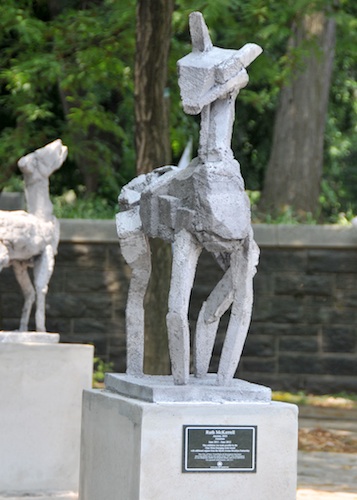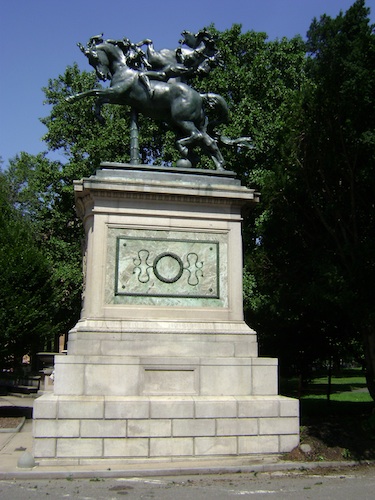The Hot Seat: Jennifer Lantzas
Welcome to The Hot Seat, where we interview folks involved in Brooklyn real estate, development, architecture and the like. Introducing Jennifer Lantzas, the Public Art Coordinator for the NYC Parks Department. Jennifer helps decide which art pieces get installed into the city’s parks. Brownstoner: How did you end up at your job with the Parks…


Welcome to The Hot Seat, where we interview folks involved in Brooklyn real estate, development, architecture and the like. Introducing Jennifer Lantzas, the Public Art Coordinator for the NYC Parks Department. Jennifer helps decide which art pieces get installed into the city’s parks.
Brownstoner: How did you end up at your job with the Parks Department? What do you do there now?
Jennifer Lantzas: I studied art history and visual arts administration as an undergrad and graduate student, and worked at several galleries and artist studios before I became the Public Art Coordinator and Curator of the Arsenal Gallery at NYC Parks. I work with artists and other arts partners to bring artworks to our public parks around the five boroughs. I also curate Parks’ public gallery space in our Central Park headquarters.
BS: What’s the decision making process behind putting a specific art piece in a specific park? Could you explain how a piece like “The Well” ended up at Cadman Plaza Park?
JL: The location of an exhibition varies with every project, as every artwork demands a different environment. Sometimes the artist or organization wants to exhibit within a specific park, but often we help artists identify locations in the Parks Department that are strong platforms for public exhibitions. [Leonard] Ursachi’s Well was particularly well suited for Cadman Plaza because the majority of the materials were found in nearby DUBMO. Ursachi, whose studio is located in DUMBO, found and reclaimed driftwood that beached along the waterfront, collected water bottles from the neighborhood and even fashioned the blocks that form the Well from a loose cobble stone from when the streets of DUMBO were repaved.
BS: What elements of artwork translate well into the public sphere?
JL: We see our public art program as one of the largest outdoor galleries in the world. Our parks are a stage for established and emerging artists to display their work and reach wider audiences than traditional gallery and museum spaces. While public artworks started out mostly as commemorative sculptures, the public has embraced the idea of art for art’s sake—opening the door for artists to use a multitude of materials, address political and social issues, and create a public dialogue. Our mission is to engage parkgoers and make them reconsider their daily spaces.
After the jump, Jennifer talks about exposing art to the elements, the Brooklyn public art scene, and her favorite public piece in the borough…
BS: Is it ever difficult for those associated with an art piece to put it into a public space? On the one hand, the artwork gains this incredible accessibility, but it’s also exposed to the elements and is suddenly out of the artist’s protection and control. There’s a sort of tension there.
JL: At the outset of any proposal we are very clear with artists about the challenges of exhibiting outdoors in a public space. Showing your work in a public park is very different from the protected environment of a gallery space. Some of these considerations include: durability, safety, the regular usage of the park space, and social responsibilities. Most artists understand these extra considerations and successfully incorporate these factors into their artwork.
BS: What kind of work do you see from Brooklyn residents? How’s the Brooklyn public art scene looking?
JL: Brooklyn artists are well represented in our Parks Program and offer a wide variety of public artworks. Currently, Ruth McKerrell, our 2011 Clare Weiss Emerging Artist Award recipient (we are currently accepting proposals for 2012), has three aluminum goat sculptures in Ft. Greene Park; Leonard Ursachi’s Well is on view in Cadman Plaza; and Rachel Owen’s sound sculpture Inveterate Composition for Clare can be seen in Manhattan’s Dag Hammarsjkold Plaza, across from the UN. Brooklyn’s public art scene has grown significantly in the past several years. Much of this is due to supportive organizations in the area that have realized the great effect art can have on public spaces—including Trust Art, the Myrtle Avenue Brooklyn Partnership, Open Space Alliance, the Public Art Fund, North Brooklyn Public Art Coalition, and the International Studio & Curatorial Program, among others.

The Well, by Leonard Ursachi. Courtesy of the artist.

Inveterate Composition for Clare, by Rachel Owen

Ruth McKerrell in Fort Greene Park
BS: Finally, your favorites: favorite BK neighborhood, favorite BK park, and favorite piece of public art in the borough.
JL: I am most familiar with Greenpoint since I used to live in the neighborhood, but there are numerous locations throughout Brooklyn that offer great public spaces.
It is too hard for me to select a favorite park in Brooklyn since they all offer such different settings and programs—for example, Owl’s Head Park has an amazing view of the river and the Verrazano Narrows Bridge; Washington Park and Old Stone House offer great educational and arts programming year round; and Robert Venable Park in East New York has recently reopened after a major restoration project and has the most amazing playground designed by New York artist Mimi Gross. And one of my favorite pieces of public art in Brooklyn is our permanent sculpture The Horse Tamers, 1899 by Frederick William MacMonnies in Prospect Park.

The Horse Tamers, by Frederick William MacMonnies.





What's Your Take? Leave a Comment